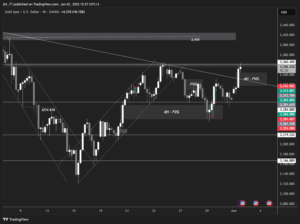Prepare for a surprise of interest rate cuts from the Federal Reserve, starting within a few months and possibly extending until next summer, according to analysts at Citigroup’s research unit. In a recent memo, the bank pointed to new signs of economic slowdown that will likely prompt the Federal Reserve to cut interest rates by 25 basis points eight times, starting from September and extending through July 2025.
The memo confirmed this would reduce interest rates by a total of 200 basis points, from the current range of 5.25% – 5.5% to 3.25% – 3.5%, remaining until the end of 2025.
Economic slowdown and the anticipated words of Powell
Led by senior US economists at Citigroup, analysts noted economic slowdown amid easing inflation pressures after some unexpected fluctuations. However, the sudden dip into negative territory by the service sector purchasing managers’ index, and the monthly jobs report showing a rise in unemployment to 4.1%, increased the risk of a sharp economic slowdown, which would accelerate interest rate cuts, according to Citigroup analysts.
Data, alongside cautious comments from Federal Reserve Chair Jerome Powell in recent days, indicate it’s highly likely the first interest rate cut could come in September. Federal Reserve Chair Jerome Powell is expected to deliver his semi-annual testimony before Congress today, Tuesday, with no new announcements anticipated. However, scrutiny of his statements will likely seek clues about the Federal Reserve’s stance on inflation and future interest rate changes.
Analysts at Piper Sandler suggest Powell will emphasize the “significant” progress made in curbing inflation, while also stressing the need for further efforts to achieve a sustainable inflation rate of 2%. Powell is expected to highlight challenges to “confidence” in inflation forecasts, indicating vigilance against potential setbacks. According to Piper Sandler, Powell’s testimony is likely to address a “balanced” view of “better” risks around Federal Reserve policy, albeit incomplete. Moreover, they suggest Powell may discuss the possibility that unexpected unemployment weakness could lead to early monetary policy easing, especially if disinflation trends persist positively. Citigroup expects “continuing economic activity declines to lead to interest rate cuts at each subsequent Federal Reserve meeting.”
Other signs of weakness
The memo also highlighted other signs of weakness in the jobs report. While core employment data of 206,000 looks strong, previous months have been revised downward. June saw a decline of 49,000 jobs in the temporary services sector, described by Citigroup as “a kind of downturn typically seen in recession periods where employers start trimming workforce.”
Citigroup also referenced the “stocks bases” recession indicator, suggesting it could be activated in August if current unemployment continues to rise. Hollenhorst has been relatively contradictory this year due to his conflicting views on the economy. In May, he doubled down on warnings that the United States was headed for a sharp downturn and that Federal Reserve interest rate cuts would not be sufficient to prevent it. This followed similar predictions in February, despite strong jobs reports.
In an interview with Bloomberg on Wednesday, Hollenhorst suggested that a severe downturn was likely to create sufficient political consensus for additional government spending to stimulate the economy, overcoming concerns about the massive deficit. However, he added that a moderate downturn might not lead to such consensus. He also pointed out that while Federal Reserve interest rate hikes led to slower economic growth than expected, interest rate cuts would not stimulate economic activity to the same extent. Additionally, 10-year bond yields, which serve as benchmarks for a wide range of borrowing costs, are already lower than yields for two-year bonds, leaving less room for further declines, especially as deficit and inflation pressures add upward pressure.
American Federal Reserve President, important comments
Federal Reserve Chair Jerome Powell recently expressed concern, Tuesday, that keeping interest rates too high for too long could jeopardize economic growth. Setting the stage for a two-day appearance on Capitol Hill this week, the central bank president said the economy remains strong, as evidenced by the labor market, despite recent slowdowns. Powell noted some easing in inflation, saying policymakers remain committed to reducing inflation to their 2% target.
In prepared remarks, he said, “At the same time, given the progress made in reducing inflation and calming the labor market over the past two years, high inflation is not the only risk we face.” Delaying political restrictions too late or less than it should could weaken economic activity and employment unnecessarily.
This comment comes as the anniversary approaches the first time since the Federal Open Market Committee raised benchmark interest rates. The overnight lending rate at the Federal Reserve is currently between 5.25% and 5.5%, the highest level in about 23 years, and a product of 11 consecutive increases since inflation reached its highest level since the early 1980s.
Encouraging inflation data
Markets expect the Federal Reserve to begin cutting interest rates in September, followed by another quarter-point reduction by year-end. However, members of the Federal Open Market Committee indicated only one cut in their June meeting. In recent days, Powell and his colleagues have indicated that recent inflation data has been somewhat encouraging following a surprising spike earlier in the year. According to the Federal Reserve’s preferred personal consumption expenditures price index, inflation reached 2.6% in May after peaking above 7% in June 2022.
Today’s statement is part of the semi-annual updates mandated by Congress on monetary policy. After making these statements, Powell will face questioning from members of the Senate Banking Committee on Tuesday and the House Financial Services Committee on Wednesday.
Oil prices rise as U.S. inventories shrink more than expected
Oil prices rose in Asian trading on Wednesday as industry data showed a larger-than-expected decline in U.S. inventories, although an increase in distillate inventories somewhat offset optimism about market tightness. Crude oil futures suffered some losses this week as talks of a potential ceasefire between Israel and Hamas led traders to price in some risk premium from oil. However, recent reports indicated that an agreement was not close.
Prices also fell on Tuesday as the impact of Tropical Storm Beryl appeared much less than expected, with the storm also weakening as it moved away from major oil infrastructure in Texas. Futures for crude oil fell during Asian trading on Wednesday. According to the New York Mercantile Exchange, the trading of crude oil futures for August reached USD81.27 per barrel at the time of writing, down by 0.17%. Trading had already been at a low USD81.25 per barrel session. Crude oil may find support at USD81.25 and resistance at USD84.52.
Dollar index futures, which measure the performance of the U.S. currency against a basket of six other major currencies, fell by 0.03% to trade at USD104.78. At the same time on Nymex, the price of Brent crude oil for September fell by 0.27% to trade at USD84.43 per barrel, while the spread between Brent crude oil contracts and crude oil stands at USD3.16 per barrel.
Disclaimer: This article is not investment advice or an investment recommendation and should not be considered as such. The information above is not an invitation to trade and it does not guarantee or predict future performance. The investor is solely responsible for the risk of their decisions. The analysis and commentary presented do not include any consideration of your personal investment objectives, financial circumstances, or needs.





